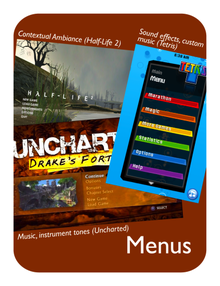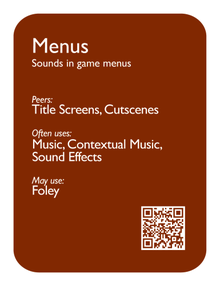Difference between revisions of "Menus"
ValterAlves (Talk | contribs) m |
ValterAlves (Talk | contribs) m |
||
| (15 intermediate revisions by the same user not shown) | |||
| Line 27: | Line 27: | ||
| revisions =Introduced in version 1.0 | | revisions =Introduced in version 1.0 | ||
| description= | | description= | ||
| − | The [[Menus]] constitute one of the | + | The [[Menus]] constitute one of the distinct components of sound design in games, along with the introductory [[Title Screens]], the [[Cutscenes]], and – the more “extensive” component – sound occurring during gameplay. |
| − | Sound in | + | Sound in [[Menus]] augments players’ [[Awareness]] for their actions. Frequently it is possible to perceive at least three kinds of semantics in [[Menus]] sounds: navigation (‘neutral’ sounds), acceptance (‘positive’ sounds), and refusal (‘negative’ sounds). |
| − | Considering that moving through items in | + | Considering that moving through items in menus is an abstract action, [[Sound Effects]] are the common solution. Yet, in order to augment the closeness between [[Menus|Menu]] sounds and game world sounds, some menus integrate elements of [[Foley]] from the gameplay. |
| − | [[Music]] is also common presence in | + | [[Music]] is also common presence in menus. Usually that is “the music of the game” (or the “soundtrack” if it applies) but it can also change along time, e.g., according to the level being played ([[Contextual Music]]). |
| examples= | | examples= | ||
| − | | ex1=<mt p="Menus" g="Uncharted" w="{{R16by9W}}" h="{{R16by9H}}">The [[Aesthetics]] of the sounds is noticeably coherent with the game experience.</mt> | + | {{NoVideoTable |{{NoVideo|'''Metal Gear Solid 4: Guns of the Patriots:''' Sounds of gun handling and firing are adopted.}} |{{NoVideo|'''Red Dead Redemption:''' Sounds of gun handling and firing are used to deliver feedback to selections and provide some playfulness to the navigation.}} | }} |
| + | | ex1=<mt p="Menus" g="Uncharted" altg="Uncharted: Drake's Fortune" w="{{R16by9W}}" h="{{R16by9H}}">The [[Aesthetics]] of the sounds is noticeably coherent with the game experience. </mt> | ||
| ex2=<mt p="Menus" g="Half Life 2" altg="Half-Life 2" w="{{R4by3W}}" h="{{R4by3H}}">When accessing the [[Menus]], the [[Ambiance]] from gameplay continues to be heard, which contributes to maintain the player connected to the game world.</mt> | | ex2=<mt p="Menus" g="Half Life 2" altg="Half-Life 2" w="{{R4by3W}}" h="{{R4by3H}}">When accessing the [[Menus]], the [[Ambiance]] from gameplay continues to be heard, which contributes to maintain the player connected to the game world.</mt> | ||
| ex3=<mt p="Menus" g="Tetris" w="{{ViPhoneW}}" h="{{ViPhoneH}}"></mt> | | ex3=<mt p="Menus" g="Tetris" w="{{ViPhoneW}}" h="{{ViPhoneH}}"></mt> | ||
| ex4=<mt p="Menus" g="Flower" w="{{R16by9W}}" h="{{R16by9H}}">In the beginning of the game, the [[Contextual Music|(Contextual) Music]] has a sad tone, accompanying a dark [[Ambiance]]. As the player completes levels they become lively and rewarding. Such evolution is in consonance with the [[Emotional Script]] of the game.</mt> | | ex4=<mt p="Menus" g="Flower" w="{{R16by9W}}" h="{{R16by9H}}">In the beginning of the game, the [[Contextual Music|(Contextual) Music]] has a sad tone, accompanying a dark [[Ambiance]]. As the player completes levels they become lively and rewarding. Such evolution is in consonance with the [[Emotional Script]] of the game.</mt> | ||
| − | | ex5=<mt p="Menus" g="Bioshock" w="{{R16by9W}}" h="{{R16by9H}}">The sounds when selecting the entries invite the user to play with the | + | | ex5=<mt p="Menus" g="Bioshock" altg="BioShock" w="{{R16by9W}}" h="{{R16by9H}}">The sounds when selecting the entries invite the user to play with the menu. They are also coherent it the game’s [[Aesthetics]].</mt> |
| ex6=<mt p="Menus" g="The Path" w="{{R32by17W}}" h="{{R32by17H}}"></mt> | | ex6=<mt p="Menus" g="The Path" w="{{R32by17W}}" h="{{R32by17H}}"></mt> | ||
| ex7=<mt p="Menus" g="Heavy Rain" w="{{R16by9W}}" h="{{R16by9H}}"></mt> | | ex7=<mt p="Menus" g="Heavy Rain" w="{{R16by9W}}" h="{{R16by9H}}"></mt> | ||
| Line 49: | Line 50: | ||
| ex11=<mt p="Menus" g="Chime" w="{{R16by9W}}" h="{{R16by9H}}"></mt> | | ex11=<mt p="Menus" g="Chime" w="{{R16by9W}}" h="{{R16by9H}}"></mt> | ||
| ex12=<mt p="Menus" g="Isaac" altg="The Binding of Isaac" w="{{R8by5W}}" h="{{R8by5H}}"></mt> | | ex12=<mt p="Menus" g="Isaac" altg="The Binding of Isaac" w="{{R8by5W}}" h="{{R8by5H}}"></mt> | ||
| − | |||
| − | |||
| ex13=<mt p="Menus" g="Rez" altg="Rez HD" w="{{R16by9W}}" h="{{R16by9H}}"></mt> | | ex13=<mt p="Menus" g="Rez" altg="Rez HD" w="{{R16by9W}}" h="{{R16by9H}}"></mt> | ||
| + | | ex14=<mt p="AcousticEcology" g="Katamari" altg="Katamari Forever" w="{{R16by9W}}" h="{{R16by9H}}">The sounds contribute to extend the gameplay into the menu.</mt> | ||
| + | |||
| + | <!--| ex4=<mt p="Menus" g="Thief III" altg="Thief III: Deadly Shadows" w="{{R4by3W}}" h="{{R4by3H}}"></mt> | ||
| + | | ex7=<mt p="Menus" g="Papa Sangre" w="{{ViPhoneH}}" h="{{ViPhoneW}}"></mt> | ||
| + | | ex8=<mt p="Menus" g="Patapon" w="{{R16by9W}}" h="{{R16by9H}}"></mt> | ||
| + | | ex11=<mt p="Menus" g="Ico" w="{{RPS2W}}" h="{{RIcoH}}"></mt> | ||
| + | | ex10=<mt p="Menus" g="Fable III" w="{{R16by9W}}" h="{{R16by9H}}"></mt> --> | ||
}} | }} | ||
Latest revision as of 02:37, 26 August 2012

|

| |
| The card's front face | The card's back face |
Contents
Synopsis
| Sounds in game menus. |
Relationships
Peers:
Title Screens ![]() , Cutscenes
, Cutscenes ![]() .
.
Often uses:
Music ![]() , Contextual Music
, Contextual Music ![]() , Sound Effects
, Sound Effects ![]() .
.
May use:
Foley ![]() .
.
Description
The Menus constitute one of the distinct components of sound design in games, along with the introductory Title Screens, the Cutscenes, and – the more “extensive” component – sound occurring during gameplay.
Sound in Menus augments players’ Awareness for their actions. Frequently it is possible to perceive at least three kinds of semantics in Menus sounds: navigation (‘neutral’ sounds), acceptance (‘positive’ sounds), and refusal (‘negative’ sounds).
Considering that moving through items in menus is an abstract action, Sound Effects are the common solution. Yet, in order to augment the closeness between Menu sounds and game world sounds, some menus integrate elements of Foley from the gameplay.
Music is also common presence in menus. Usually that is “the music of the game” (or the “soundtrack” if it applies) but it can also change along time, e.g., according to the level being played (Contextual Music).
Examples
| Metal Gear Solid 4: Guns of the Patriots: Sounds of gun handling and firing are adopted. |
Red Dead Redemption: Sounds of gun handling and firing are used to deliver feedback to selections and provide some playfulness to the navigation. |
  Uncharted: Drake's Fortune: The Aesthetics of the sounds is noticeably coherent with the game experience.
|
  Half-Life 2: When accessing the Menus, the Ambiance from gameplay continues to be heard, which contributes to maintain the player connected to the game world.
|
  Flower: In the beginning of the game, the (Contextual) Music has a sad tone, accompanying a dark Ambiance. As the player completes levels they become lively and rewarding. Such evolution is in consonance with the Emotional Script of the game.
|
  BioShock: The sounds when selecting the entries invite the user to play with the menu. They are also coherent it the game’s Aesthetics.
|









